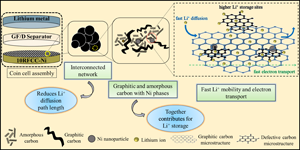Crossref Citations
This article has been cited by the following publications. This list is generated based on data provided by
Crossref.
Hou, Jiazi
Mao, Xinyu
Wang, Jinyang
Liang, Ce
and
Liang, Jicai
2021.
Preparation of rice husk-derived porous hard carbon: A self-template method for biomass anode material used for high-performance lithium-ion battery.
Chemical Physics,
Vol. 551,
Issue. ,
p.
111352.
Gaikwad, Mayur M.
Sarode, Krishna K.
Pathak, Anil D.
and
Sharma, Chandra S.
2021.
Ultrahigh rate and high-performance lithium-sulfur batteries with resorcinol-formaldehyde xerogel derived highly porous carbon matrix as sulfur cathode host.
Chemical Engineering Journal,
Vol. 425,
Issue. ,
p.
131521.
Yang, Su Hyun
Lee, Yun Jae
Kang, Heemin
Park, Seung-Keun
and
Kang, Yun Chan
2022.
Carbon-Coated Three-Dimensional MXene/Iron Selenide Ball with Core–Shell Structure for High-Performance Potassium-Ion Batteries.
Nano-Micro Letters,
Vol. 14,
Issue. 1,
Destyorini, Fredina
Amalia, Windi Cahya
Irmawati, Yuyun
Hardiansyah, Andri
Priyono, Slamet
Aulia, Fauzan
Oktaviano, Haryo S.
Hsu, Yu-I
Yudianti, Rike
and
Uyama, Hiroshi
2022.
High Graphitic Carbon Derived from Coconut Coir Waste by Promoting Potassium Hydroxide in the Catalytic Graphitization Process for Lithium-Ion Battery Anodes.
Energy & Fuels,
Vol. 36,
Issue. 10,
p.
5444.
Frankenstein, Lars
Glomb, Pascal
Ramirez‐Rico, Joaquin
Winter, Martin
Placke, Tobias
and
Gomez‐Martin, Aurora
2023.
Revealing the Impact of Different Iron‐Based Precursors on the ‘Catalytic’ Graphitization for Synthesis of Anode Materials for Lithium Ion Batteries.
ChemElectroChem,
Vol. 10,
Issue. 5,
Tai, Yuehui
Sun, Jinlong
Tian, Haoran
Liu, Fuyue
Han, Boyu
Fu, Wei
Liu, Zhangpei
Yang, Xiuye
and
Liu, Qifeng
2023.
Efficient degradation of organic pollutants by S-NaTaO3/biochar under visible light and the photocatalytic performance of a permonosulfate-based dual-effect catalytic system.
Journal of Environmental Sciences,
Vol. 125,
Issue. ,
p.
388.
Veselov, Grigory
and
Vedyagin, Aleksey
2023.
Resorcinol–Formaldehyde-Derived Carbon Xerogels: Preparation, Functionalization, and Application Aspects.
Materials,
Vol. 16,
Issue. 19,
p.
6566.
Jurkiewicz, Karolina
Liszka, Barbara
Gancarz, Paweł
Smykała, Szymon
Zygadło, Dorota
Nokielski, Patryk
Lamrani, Taoufik
Talik, Ewa
Wrzalik, Roman
Walkowiak, Mariusz
and
Ilavsky, Jan
2024.
Sucrose‐Based Dense, Pure, and Highly‐Crystalline Graphitic Materials for Lithium‐Ion Batteries.
Advanced Functional Materials,
Vol. 34,
Issue. 51,
Bharti, Vikram Kishore
Goswami, Ashish Priyam
Sharma, Chandra Shekhar
and
Khandelwal, Mudrika
2024.
Bacterial cellulose-derived carbon as a self-supported and flexible anode for stable-performance lithium-ion batteries.
Journal of Electroanalytical Chemistry,
Vol. 957,
Issue. ,
p.
118142.
Cherian, Sony K.
Gaikwad, Mayur M.
Nanaji, Katchala
Sarada, Bulusu V.
Rao, Tata Narasinga
and
Sharma, Chandra S.
2024.
Iron, cobalt co-embedded in situ graphitized xerogel-derived carbon as sulfur host for ultrahigh rate and high-performance lithium-sulfur batteries.
Journal of Energy Storage,
Vol. 95,
Issue. ,
p.
112587.
Zhao, Chongjun
Guo, Huiming
Zhu, Beibei
Li, Mingkun
Tong, Xiangzhi
Gao, Wenjie
Zhu, Yunpeng
and
Zhao, Chunhua
2024.
Epoxy resin-derived N, P co-doping hard carbon with improved yield and anode performance in Li-ion battery.
Ionics,
Vol. 30,
Issue. 4,
p.
1971.
Liu, Yuqing
Carvalho, Alexandra
Lai, Wenhui
Pu, Yanhui
Zhang, Zheng
Lim, Sharon Xiaodai
Castro Neto, Antonio H.
Gupta, Puneet
and
Sow, Chorng Haur
2025.
Enhanced battery performance by fluorescent defects engineering in hard carbon anodes.
Chemical Engineering Journal,
p.
163279.
Jeong, Harok
Kim, JeongA
Lee, Sang-Hyun
Kim, Dae Up
Kim, Jungpil
and
Yang, Junghoon
2025.
Iron-catalyzed graphitization of lignocellulose: A pathway to develop artificial graphite as anode materials for lithium-ion batteries applications.
Journal of Alloys and Compounds,
Vol. 1020,
Issue. ,
p.
179485.
